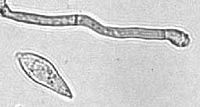Magnaporthe grisea, also known as rice blast fungus, rice rotten neck, rice seedling blight, blast of rice, oval leaf spot of graminea, pitting disease, ryegrass blast, Johnson spot,[1][2][3][4][5][6][7] and neck blast[8][9][10][11] is a plant-pathogenic fungus and model organism[12] that causes a serious disease affecting rice. It is now known that M. grisea consists of a cryptic species complex containing at least two biological species that have clear genetic differences and do not interbreed.[13] Complex members isolated from Digitaria have been more narrowly defined as M. grisea. The remaining members of the complex isolated from rice and a variety of other hosts have been renamed Magnaporthe oryzae, within the same M. grisea complex.[13] Confusion on which of these two names to use for the rice blast pathogen remains, as both are now used by different authors.
Members of the Magnaporthe grisea complex can also infect other agriculturally important cereals including wheat, rye, barley, and pearl millet causing diseases called blast diseaseor blight disease. Rice blast causes economically significant crop losses annually. Each year it is estimated to destroy enough rice to feed more than 60 million people. The fungus is known to occur in 85 countries worldwide[14] and as of 2003 was the most devastating fungal plant pathogen in the world.[12]
| Magnaporthe grisea | |
|---|---|
 | |
| A conidium and conidiogenous cell of M. grisea | |
| Scientific classification | |
| Kingdom: | |
| Phylum: | |
| Class: | |
| Order: | |
| Family: | |
| Genus: | |
| Species: | M. grisea |
| Binomial name | |
| Magnaporthe grisea (T.T. Hebert) M.E. Barr | |
| Synonyms | |
Ceratosphaeria grisea T.T. Hebert, (1971) | |
https://en.wikipedia.org/wiki/Magnaporthe_grisea
No comments:
Post a Comment